What Fashion Week Is Like for a Curve Model
Size diversity is something consumers demand and celebrate when they see it on the runway—and call out when they don't. Progress on this front has been gradual, at best. But season after season, we are seeing more brands cast curvy models for their Fashion Week presentations. (For fall 2019, Area and Veronica Beard were among a small number to introduce body diversity to their shows; Prabal Gurung, Cushnie, and Christian Siriano continued building on past seasons by once again casting models of all sizes.) Because of these changes, a few women have risen to a level of Fashion Week fame once afforded only to straight-size models: the Ashley Grahams, Candice Huffines, Marquita Prings.
Still, Fashion Week, from the prep to the walk down the runway, can be an emotional experience for curve models: There’s the anxiety of go-sees, the frustration with designers who have yet to include curvy models, the camaraderie backstage at size-inclusive show, and most of all, a sense of pride in the shared mission of making the fashion world a more inclusive place.
“I want the world to see that more than one kind of body—the kind of body that fashion has forever perpetuated as the only acceptable one—is valuable and worthy and deserving of representation,” says Lauren Chan, a model and former Glamour editor. “If me showing up in a bathing suit on the runway and having a picture on vogue.com gets that message across, then I’m happy to do it.”
What viewers see as empowering progress or lagging representation on the runway is more complex for the women living it. We spoke with five models—Huffine, Pring, Chan, as well as Mama Cax and Precious Lee—to hear what happens in the moments leading up to and on the catwalk. No single experience is emblematic of every curve model at Fashion Week, but together their accounts show us the nuances of being faces of change and give us reason to be optimistic about the runway’s future.
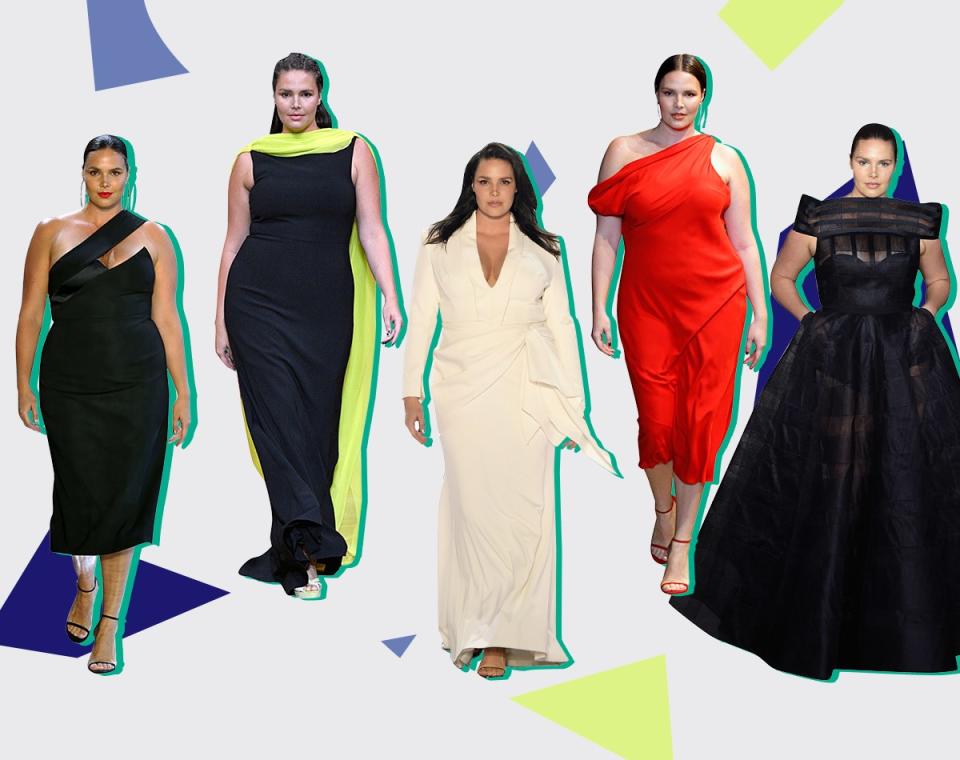
“We’ve been waiting to see this for so long.”
“Marquita Pring and I have done the show circuit since 2015. We always look at each other and we’re like, ‘There’s nobody I’d rather be doing this with than you.’ Because we know that it really means something that we’re there. For a while, you could count on one hand the curve girls you would see at every single casting. Now I’m seeing the casting process open up a lot more. Where it goes from there, you can’t make any guarantees—but it’s nice that you’re in the door.
“The casting process this time has been very similar to past seasons. I’m casting with a lot of the designers I’ve previously walked for. You go see them again, walk for them again, and maybe try on some new dresses. I don’t ever make any assumptions that I’m a shoe-in for a show, but it’s always amazing to go back and see the mainstay supporters of this inclusive movement. There are the Christian Sirianos, the Cushnies, the Prabals. When you’re [going through] casting, you’re excited to see them pop up in your email again, because you know that [size diversity] isn’t a temporary thing for them—it’s something that’s going to be a part of their brand ethos and runway vision for life.
“Although the list of castings for a curvy girl like myself isn’t long, I will say that I’m more and more excited by the new additions every season. Those moments where we’re all intertwined on a runway, celebrating women and showcasing fashion, gives a little aha moment to designers, to realize that you don’t have to do something wildly different for this curvy customer—you can beautifully integrate a variety of women into your shoot, your magazine, your campaign, whatever it may be, and it’s so welcomed.
“The 11 Honoré show was my first this Fashion Week. I was like, Is Fashion Week done after tonight? It was crazy—a full celebration. There was a happiness and excitement that you don’t see at shows very often. Laverne Cox coming out in that amazing tulle dress, glitter confetti coming from the ceiling…. There was an extra wow factor and specialness because of the women that you were seeing. At the end my husband said, ‘It’s been a long time coming, getting here.’ I feel like everyone feels that way—we’ve been waiting to see this for so long, when you finally see it, you’re like, Oh hell yes. Like, I cannot believe my eyes. I’m finally represented on a runway.” —Candice Huffine
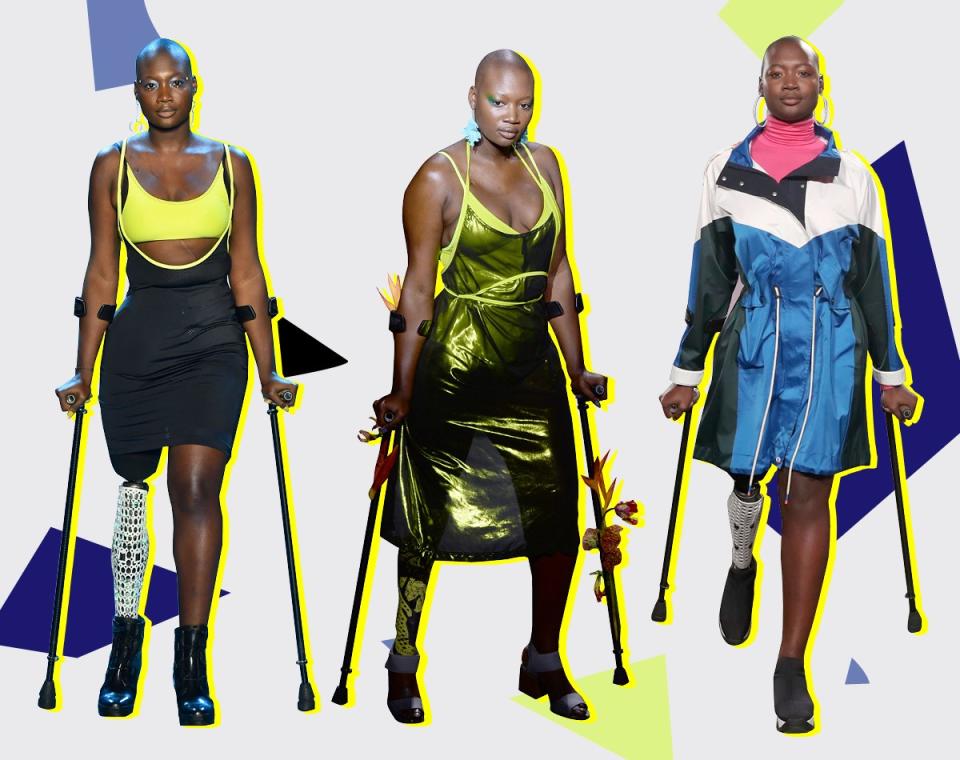
“If I’m using my crutches, people assume that something is wrong.”
“Prior to making my debut at Fashion Week last season, I had been modeling for only three months. Chomat was my first show—they had reached out to me for a campaign, and then I was asked to walk their runway. I always told myself if there was a show I would walk for, it would be Chromat. I’d always admired the diversity on their catwalk.
“Sometimes castings are in [a] space that is not accessible—it’s one of the things that I think about: If someone wanted to break into the industry and they’re not physically able to go up the stairs, that automatically excludes them from being part of it. I’m lucky enough to be able to get around stairs, but it makes me think of a group of people who are excluded from that experience altogether.
“I’ve been to castings where I’m the bigger person in the room, and I’m only a size 10. I’ve been to ones where I’m the darkest person in the room. I’m so used to such a diverse group from my agency, that always surprises me. I’m a confident person, but it can be intimidating to go into this room where everyone is vying for that job that only a few can get, and there’s so many beautiful, amazing personalities. You find yourself dissecting your own body and having small insecurities crawl up. But it’s good to remind myself that if I’m there, I deserve to be there, and I’m going to give it my best.
“I always figure that if I go to a casting, that specific brand has the goal of becoming more diverse—that’s not to say that they’re specifically trying to include disabilities, because I guess I’m considered a plus-size model, but sometimes it’s how I see it. Oftentimes, people are surprised that I’m there. I get asked questions that are borderline weird—like, if I’m wearing long jeans and using my crutches, the first question I get asked is, ‘What happened to you?’ That’s part of living in an ableist world: If they see that I’m using an assistive device, people assume that something is wrong. There’s a lot at play that an average model doesn’t have to go through.
“My goal is to always to create more opportunities for people with disabilities. When people talk about inclusion and making things more diverse, you think about a brand that has one person with curves, and that’s everyone’s go-to person—that’s what I don’t want it to be.
“I hope that the more I do Fashion Week, the more normal it’ll be, that people will simply talk about the clothes we’re wearing, as opposed to it being about a person walking this show despite having a disability.” —Mama Cax
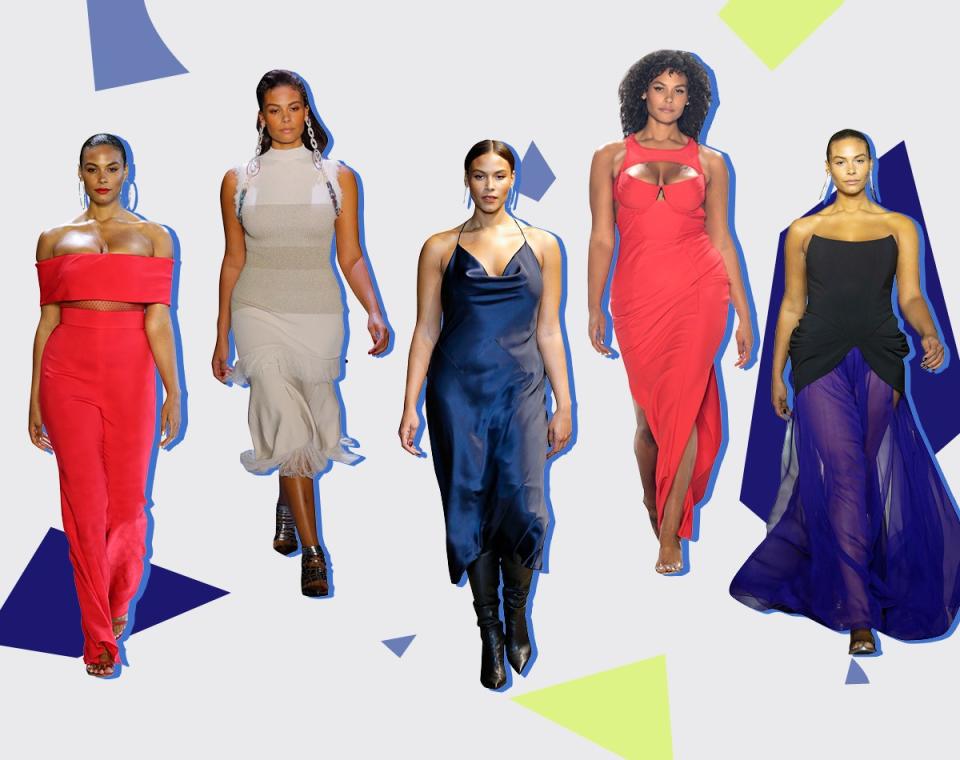
“For so long, Fashion Week wasn’t considered an option.”
“In 2016 Christian Siriano had his first show where he included curve models, and that’s when I realized that, OK, I look incredible on that runway. I should be able to do this on every single runway. For so long Fashion Week wasn’t considered an option—it was an automatic no.“
“Going into castings more recently, I don’t feel like I stand out. I don’t feel like people are wondering what I’m doing there. I feel like I’m exactly where I belong—whereas a few years ago, even going into that first casting with ALDA [a curve model collective], we walked in and it was just like, ‘What are these people doing here?’ I think it has definitely become much more of the norm now. It’s not surprising to see curvy women on the runway.
“I guess Fashion Week is not as crazy or overwhelming [as it might be for] straight-size models, because our options are still quite limited. So while I have five castings in a day, they’ve got more. I’m really happy I don’t have to deal with that. At a casting for a curvy client, it’s usually a very lighthearted—everyone’s saying hi and catching up; then you go to a casting that’s for all models or just straight-size ones, and it’s just quiet and not much is happening.
“I think designers are definitely more conscious and aware that they need to be putting more relatable women in their shows. I do wish and hope that more and more women like me are on these runways. I want to be that high-end designer girl.
“I’ll never forget this one show—it was three years ago and it was still pretty new for me. I remember changing and I kept seeing these girls staring. Especially this one girl, she couldn’t take her eyes off me. And I was like, What is this? I have no idea what she’s thinking, but I’m just assuming the worst, right? I wasn’t going to let that get me down, but it was definitely something that I was aware of. After the show she pulled me aside, and she’s like, ‘I just have to say, you look so amazing! Your body is so womanly.’ I get emotional even thinking about it. It’s stuff like that, where you automatically assume the worst, and then you have that moment when you realize you have no idea what someone else is thinking and, second of all, holy shit. It’s kind of a reminder that we’re all in this together.” —Marquita Pring
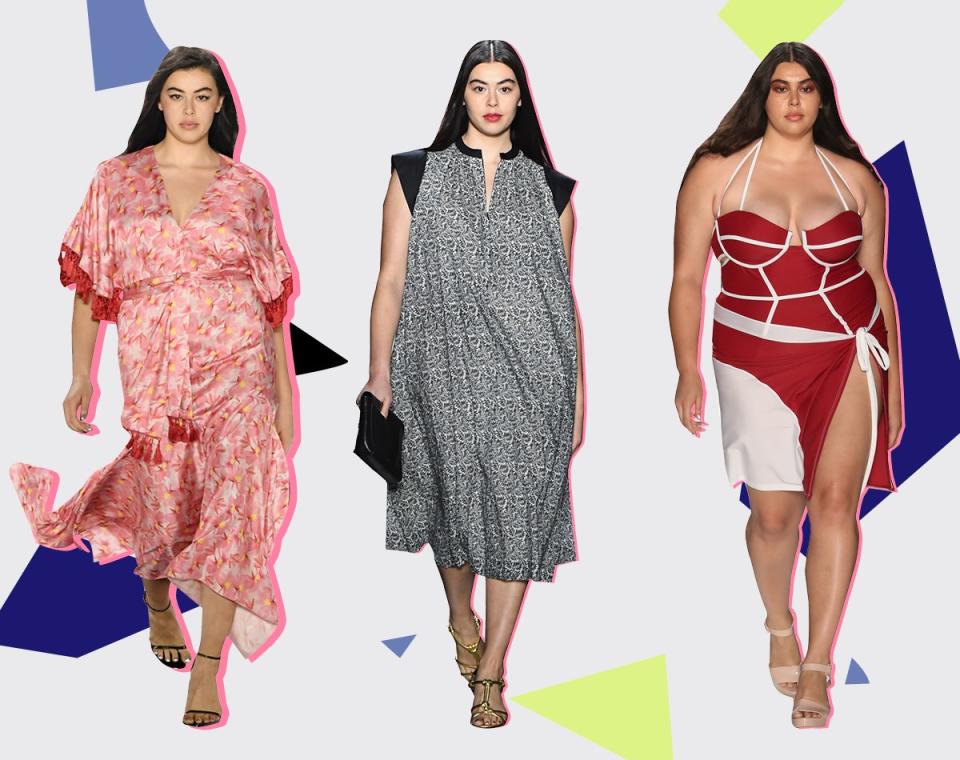
“When you get a group of us together and give us a stage to celebrate, we make up for lost time.”
“I’ve been personally trying to put my money where my mouth is on my message about size inclusion in fashion. I’m starting my own company. I’m trying to put myself out there on social more. Returning to Fashion Week felt like something I needed to do to make it a positive experience for myself and to continue to lead by example.
“I’ve been taking notes at the castings I’ve been to, to keep track of what’s happening. At each one that I’ve been to, there’s been a pretty big proportion of curve girls or plus-size models. At the Chromat one, it was definitely at least half. At the other ones I’ve been to, it’s been like a pretty solid half-and-half, I’d say.
“One major, huge change that I almost can’t believe is happening is that people want a plus-size Asian girl. When I first was a plus-size model in 2012, everybody I worked with was pretty cookie-cutter, to be honest. And now…I joke, but it’s like they see me and they’re like, ‘You’re Chinese and plus, and you have freckles? Come on in!’ My 2012 self would probably hear that and think that a trick was being played on her.
“I hate to say it, but observing the industry this way, the shows that feel more likely [for me to be cast in] are not the super high-fashion ones—if a plus-size model is walking [a high fashion show], it's usually one or two and the same ones. It’s not that it’s a bad thing, it just seems less attainable for more girls.
"Walking in the 11 Honoré show was the best return to Fashion Week I could have imagined. Next to Chromat's shows, it was the most celebratory one I've ever been to—as a model or as an editor. Much like Chromat, it was about celebrating people who have been previously excluded from fashion. When you get a group of people like that together and give us a stage to celebrate, we make up for lost time.
“The moment after I finished my turn, I had a big smile on my face. It was impossible not to! I was Look 5, so there was still a big group of models—and Laverne [Cox]—waiting to get out there with really excited energy. It was fun to see that through new eyes, with the relief of having just walked. All of my nervousness was gone and it felt like a party. We knew Laverne was going to perform, but we didn’t know about the confetti, so when we got out there for the finale to see it falling from the sky, a lot of us were laughing and cheering. If you look back at any of those photos, you can see the pure joy on our faces.” —Lauren Chan
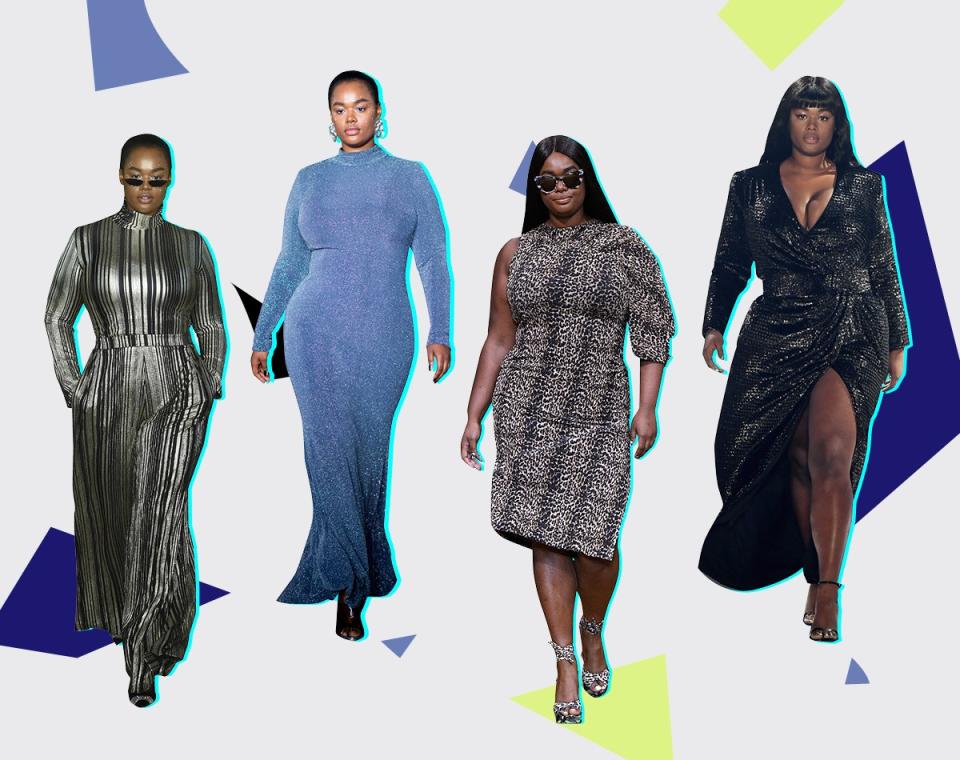
“Although I’m fighting to break down barriers, I don’t have to put myself in a position where I’m not appreciated.”
“Everything that I do is going to be done by a black curvy woman, because that’s who I am. Walking in Fashion Week, or even going to certain castings, is something that is super important to me. I feel pressure in general as a model: Fashion Week is stressful—it’s physically draining and there’s a lot going on. [There’s] pressure for me to perform at the highest level because almost everything that I’m doing is a ‘first this’ or a ‘monumental that.’ But it’s also a lot of opportunity to grow and to expand the platform—not just for curvy women or curvy black women, but a different type of woman in an industry that you don’t normally see.
“I see each season that designers are a little more open, I feel, to a curve model. I would personally love to see it accelerated, but I’m also grateful to see changes. It’s a lot about what’s going on outside of Fashion Week that is making designers take a look and really see how major it can be to have curves.
“It’s a different vibe when you’re in a space of a lot of all curvy women, versus a show where it’s some curves and some straight-size clothes. What really stood out to me [at 11 Honoré] was the styling of the show and the selection of the pieces—it was just amazing to see and show that you can have Brandon Maxwell in a size 14. I was super grateful that it was all of those high-end designers that you don’t typically think of in extended sizes.
“Fashion Week for me is not about specific designers. Of course I would want to walk every show that I like or that has never used curve girls before. But I realized that, although I’m fighting to break down barriers, I don’t have a desire to put myself in a position where I’m literally not appreciated or desired.
“I definitely think that seeing me on the runway has afforded me so many different opportunities job-wise. I think people really like to see me in action, speaking, seeing me on the runway or on the red carpet. Seeing my personality come out in different ways through Fashion Week is an opportunity for me to show different sides to myself.” —Precious Lee
Interviews have been edited for length and clarity.
Halie LeSavage is the fashion associate at Glamour. Follow her @halielesavage.

